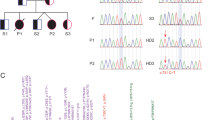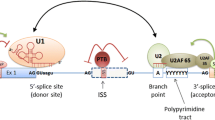Abstract
Ellis–van Creveld syndrome (EvC) is caused by mutations in EVC and EVC2, genes in a divergent orientation separated by only 2.6 kb. We systematically sought mutations in both genes in a panel of 65 affected individuals to assess the proportion of cases resulting from mutations in each gene. We PCR amplified and sequenced the coding exons of both genes. We investigated mutations that could affect splicing by in vitro splicing assays and cDNA analysis. We have identified EVC mutations in 20 cases (31%); in all of these we have detected the mutation on each allele. We have identified EVC2 mutations in 25 cases (38%); in 22 of these we have isolated a mutation on each allele. The majority of the mutations introduce a premature termination codon. We sequenced the region between the two genes in 10 of the 20 cases in which we had not identified a mutation in either gene, revealing only one SNP that was not a common polymorphism. As we have not identified mutations in either gene in 20 cases (31%) it is possible that there is further genetic heterogeneity.



Similar content being viewed by others
References
Antonarakis SE (1998) Recommendations for a nomenclature system for human gene mutations nomenclature working group. Hum Mutat 11:1–3
Digilio MC, Marino B, Giannotti A, Dallapiccola B (1995) Single atrium, atrioventricular canal/postaxial hexodactyly indicating Ellis–van Creveld syndrome. Hum Genet 96:251–3
Digilio MC, Marino B, Ammirati A, Borzaga U, Giannotti A, Dallapiccola B (1999) Cardiac malformations in patients with oral-facial-skeletal syndromes: clinical similarities with heterotaxia. Am J Med Genet 84:350–6
Draper N, Walker EA, Bujalska IJ, Tomlinson JW, Chalder SM, Arlt W, Lavery GG, Bedendo O, Ray DW, Laing I, Malunowicz E, White PC, Hewison M, Mason PJ, Connell JM, Shackleton CH, Stewart PM (2003) Mutations in the genes encoding 11beta-hydroxysteroid dehydrogenase type 1 and hexose-6-phosphate dehydrogenase interact to cause cortisone reductase deficiency. Nat Genet 34:434–9
Ellis RWB, van Creveld S (1940) A syndrome characterised by ectodermal dysplasia, polydactyly, chondro-dysplasia and congenital morbus cordis: report of three cases. Arch Dis Child 15:65–84
Floeth M, Bruckner-Tuderman L (1999) Digenic junctional epidermolysis bullosa: mutations in COL17A1 and LAMB3 genes. Am J Hum Genet 65:1530–7
Hentze MW, Kulozik AE (1999) A perfect message: RNA surveillance and nonsense-mediated decay. Cell 96:307–10
Hill RD (1977) Two cases of Ellis–van Creveld syndrome in a small island population. J Med Genet 14:33–36
Kajiwara K, Berson EL, Dryja TP (1994) Digenic retinitis pigmentosa due to mutations at the unlinked peripherin/RDS and ROM1 loci. Science 264:1604–8
Katsanis N, Ansley SJ, Badano JL, Eichers ER, Lewis RA, Hoskins BE, Scambler PJ, Davidson WS, Beales PL, Lupski JR (2001) Triallelic inheritance in Bardet–Biedl syndrome, a Mendelian recessive disorder. Science 293:2256–9
McIntosh (1933) In: Holt, Howland (eds) Diseases of infancy and childhood, 10th edn Appleton-Century-Crofts, New York, pp 362
McKusick VA, Egeland JA, Eldridge R, Krusen DE (1964) Dwarfism in the Amish. I. The Ellis–van Creveld syndrome. Bull Johns Hopkins Hosp 115:306–336
Polymeropoulos MH, Ide SE, Wright M, Goodship J, Weissenbach J, Pyeritz RE, Da Silva EO, Ortiz De Luna RI, Francomano CA (1996) The gene for the Ellis–van Creveld syndrome is located on chromosome 4p16. Genomics 35:1–5
Ruiz-Perez VL, Ide SE, Strom TM, Lorenz B, Wilson D, Woods K, King L, Francomano C, Freisinger P, Spranger S, Marino B, Dallapiccola B, Wright M, Meitinger T, Polymeropoulos MH, Goodship J (2000) Mutations in a new gene in Ellis–van Creveld syndrome and Weyers acrodental dysostosis. Nat Genet 24:283–6
Ruiz-Perez VL, Tompson SW, Blair HJ, Espinoza-Valdez C, Lapunzina P, Silva EO, Hamel B, Gibbs JL, Young ID, Wright MJ, Goodship JA (2003) Mutations in two nonhomologous genes in a head-to-head configuration cause Ellis–van Creveld syndrome. Am J Hum Genet 72:728–32
Savage DB, Agostini M, Barroso I, Gurnell M, Luan J, Meirhaeghe A, Harding AH, Ihrke G, Rajanayagam O, Soos MA, George S, Berger D, Thomas EL, Bell JD, Meeran K, Ross RJ, Vidal-Puig A, Wareham NJ, O’Rahilly S, Chatterjee VK, Schafer AJ (2002) Digenic inheritance of severe insulin resistance in a human pedigree. Nat Genet 31:379–84
da Silva EO, Janovitz D, de Albuquerque SC (1980) Ellis–van Creveld syndrome: report of 15 cases in an inbred kindred. J Med Genet 17:349–56
Spranger S, Tariverdian G (1995) Symptomatic heterozygosity in the Ellis–van Creveld syndrome? Clin Genet 47:217–20
Wallace AJ (2003) Mutation scanning for the clinical laboratory: automated fluorescent sequencing. In: Elles R, Mountford R (eds) Molecular diagnosis of genetic diseases, 2nd edn Humana press, pp 81–114
Yau SC, Bobrow M, Mathew CG, Abbs SJ (1996) Accurate diagnosis of carriers of deletions and duplications in Duchenne/Becker muscular dystrophy by fluorescent dosage analysis. J Med Genet 33:550–58
Ye X, Song G, Fan M, Shi L, Jabs EW, Huang S, Guo R, Bian Z (2006) A novel heterozygous deletion in the EVC2 gene causes Weyers acrofacial dysostosis. Hum Genet 119:199–205
Acknowledgments
This work was funded by the British Heart Foundation and European Commission (QLG1-2001-02188). We would like to acknowledge all clinicians that sent us samples for screening.
Author information
Authors and Affiliations
Corresponding author
Electronic supplementary material
Rights and permissions
About this article
Cite this article
Tompson, S.W.J., Ruiz-Perez, V.L., Blair, H.J. et al. Sequencing EVC and EVC2 identifies mutations in two-thirds of Ellis–van Creveld syndrome patients. Hum Genet 120, 663–670 (2007). https://doi.org/10.1007/s00439-006-0237-7
Received:
Accepted:
Published:
Issue Date:
DOI: https://doi.org/10.1007/s00439-006-0237-7




